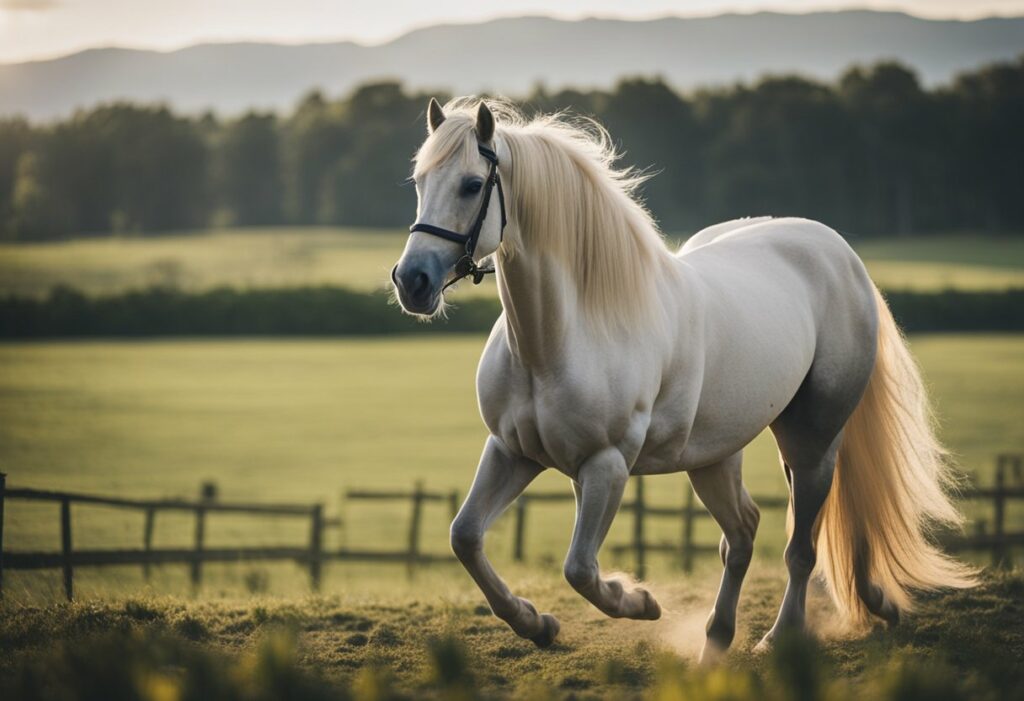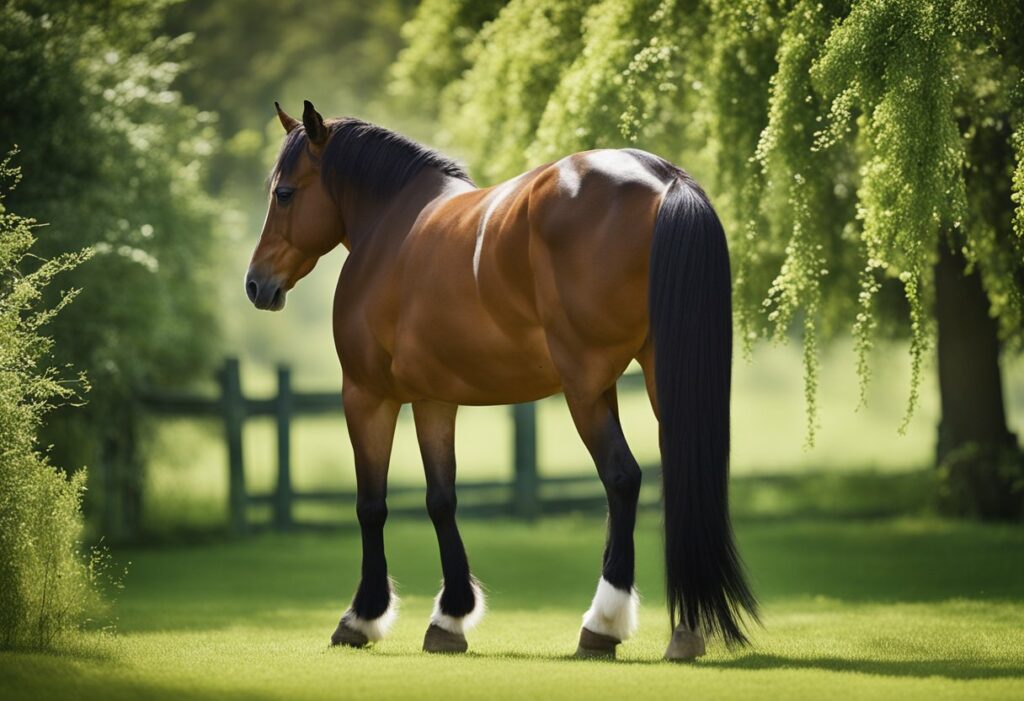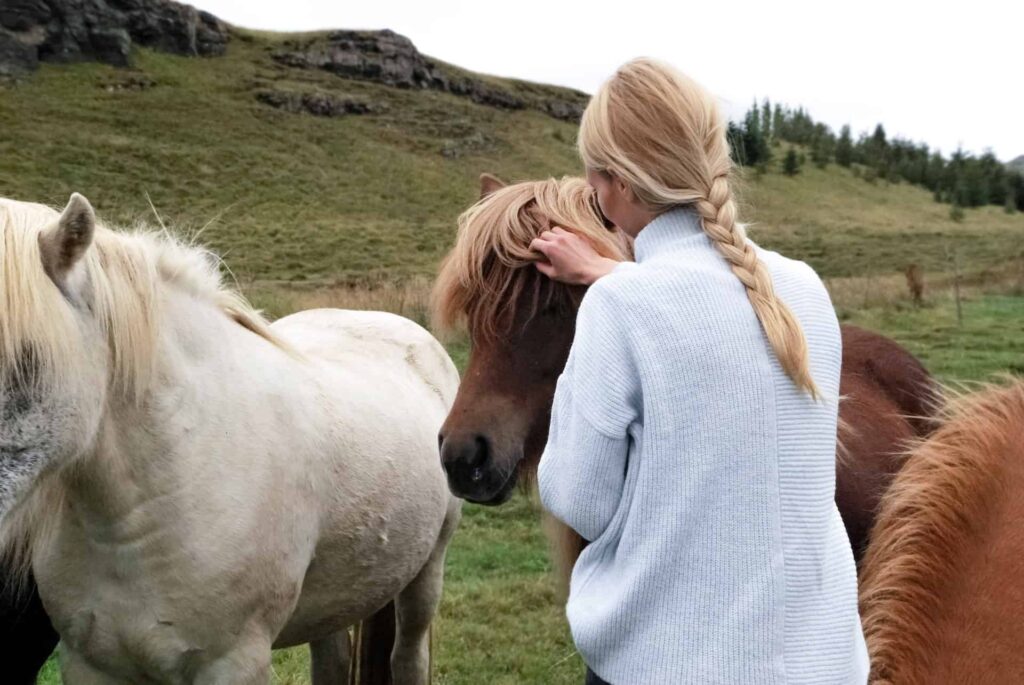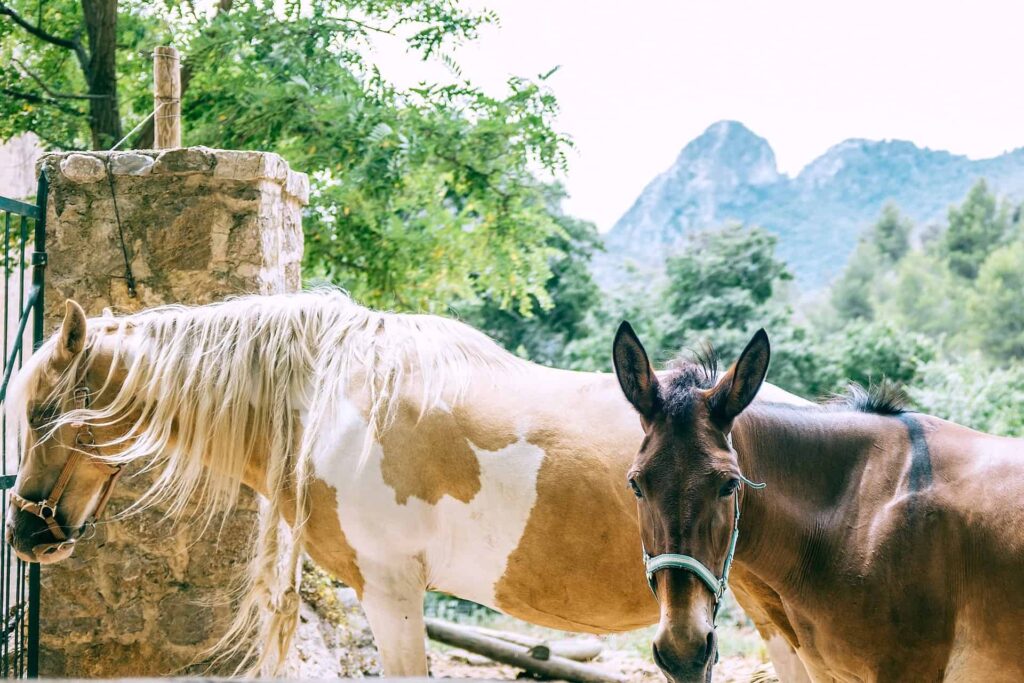Horse heat cycles, also known as estrous cycles, are an important aspect of equine reproduction. Understanding these cycles is vital for horse owners, breeders, and veterinarians alike. The heat cycle is a complex process that involves hormonal changes and various physical signs observed in mares. It is crucial for managing horse breeding, reproductive health, and overall mare care.
Mares typically experience heat cycles from spring to fall, usually lasting about 21 days, with the majority of the cycle being the non-receptive period, called diestrus, and a shorter receptive phase to the stallion, known as estrus. Hormonal interactions between the hypothalamus, pituitary gland, and ovaries regulate these cycles, ensuring the mare’s reproductive system remains in sync with external factors such as day length and temperature.
Recognizing the signs of heat in a mare can aid in optimized breeding management, resulting in successful conception and pregnancy. Horse owners need to be familiar with the mare’s behavior and physical changes during estrus, such as increased tail raising, frequent urination, and willingness to accept a stallion. Understanding the interaction between stallions and mares during the heat cycle can help guide decisions on breeding timeframes and mare care.
Key Takeaways
- Horse heat cycles involve hormonal changes and physical signs in mares
- Recognizing signs of heat is crucial for breeding management and reproductive health
- Hormonal interactions regulate the mare’s reproductive system and influence breeding success
Understanding Horse Heat Cycles
The horse heat cycle, also known as the estrous cycle, plays a crucial role in horse breeding. It is fundamental for breeders to have a comprehensive understanding of the processes involved in the cycle to effectively manage and optimize their breeding programs.
The estrous cycle comprises four major phases: proestrus, estrus, metestrus, and diestrus. In some cases, an additional phase called anestrus or reproductive quiescence may occur, particularly during the winter months or when a mare is not cycling.
Proestrus marks the beginning of the estrous cycle when follicles start to grow within the mare’s ovaries. Hormonal changes, specifically an increase in estrogen production, stimulate the growth and development of the follicle.
Estrus is commonly referred to as the heat period, which typically lasts for five to seven days. During this phase, the mare is receptive to breeding and exhibits behavioral changes such as increased vocalization, tail raising, and increased urination. Estrogen levels peak and ovulation occurs towards the end of estrus, releasing a mature egg ready for fertilization.
Following ovulation, the metestrus stage commences, lasting for about three days. The empty follicle turns into the corpus luteum, which produces progesterone, a hormone that helps maintain pregnancy if fertilization occurs.
Diestrus is the longest phase of the estrous cycle, lasting approximately 14 days. Progesterone levels continue to rise, preparing the uterus for possible embryo implantation. If the mare is not pregnant, the corpus luteum regresses, causing a decline in progesterone levels and signaling the beginning of a new cycle.
In some instances, anestrus can occur when the mare enters a period of reproductive quiescence. This phase is characterized by a lack of hormonal activity, and the mare does not exhibit any heat cycle signs. Anestrus can be influenced by factors such as day length, nutrition, and stress.
Understanding these phases and their hormonal interplay is vital for managing and planning successful horse breeding programs. Timely interventions such as hormone therapy and artificial light manipulation can help shorten the transitional periods between cycles, resulting in a more predictable and efficient breeding season.
Biological Aspects and Hormonal Influence
Ovarian Activity
In mares, the reproductive cycle is primarily determined by the ovarian activity. The ovaries play a vital role in the release of eggs (ovulation) and hormone production to regulate the estrous cycle. The main stages of ovarian activity include follicular development, ovulation, and corpus luteum formation. The cycle begins with follicles growing on the ovaries, stimulated by the secretion of gonadotropin-releasing hormone (GnRH) from the hypothalamus. Once the follicles reach maturity, they release the egg during ovulation, influenced by the surge of luteinizing hormone (LH) from the pituitary gland. After ovulation, the corpus luteum forms in the place of ruptured follicles and is responsible for progesterone production, which is crucial for the maintenance of pregnancy.
Melatonin secretion from the pineal gland also plays a role in mare’s reproductive activity, as it influences the seasonality of their estrous cycle. Mares are seasonally polyestrous, meaning that they experience multiple estrous cycles during the breeding season and a period of reproductive inactivity during the non-breeding season. This seasonality is closely linked to the fluctuations in melatonin secretion due to changes in daylight hours.
Hormonal Changes
Throughout the estrous cycle, mares experience hormonal fluctuations that regulate the various stages of ovarian activity and the mare’s receptivity to breeding. The primary reproductive hormones involved in this process include:
- Estrogen: Produced by the developing follicles, estrogen is a key hormone responsible for preparing the mare’s reproductive tract for breeding and initiating sexual behavior. High estrogen levels trigger the release of GnRH, stimulating the surge of LH necessary for ovulation.
- Progesterone: Secreted by the corpus luteum after ovulation, progesterone ensures the maintenance of pregnancy by suppressing estrus behavior and preparing the uterus for embryo implantation.
- Gonadotropin-releasing hormone (GnRH): Produced by the hypothalamus, GnRH stimulates the release of LH and follicle-stimulating hormone (FSH) from the pituitary gland, promoting follicle maturation and ovulation.
- Luteinizing Hormone (LH): LH is released from the pituitary gland in response to GnRH, and it is responsible for triggering ovulation and stimulating the formation of the corpus luteum.
- Follicle-Stimulating Hormone (FSH): Also released from the pituitary gland, FSH stimulates the growth and development of follicles in the ovaries.
- Prostaglandin F2α (PGF2α): Produced by the uterus, prostaglandin is responsible for the regression of the corpus luteum when pregnancy does not occur, leading to a decrease in progesterone levels and subsequent initiation of a new estrous cycle.
These hormonal changes interact in a complex manner to regulate the mare’s reproductive cycle, ensuring their readiness for breeding during the appropriate season and promoting the necessary ovarian activity for fertility.

Identifying Signs of Heat in a Mare
Mares exhibit various behavioral and physical signs when they are in heat, which is also known as estrus. During this phase of the estrous cycle, the mare is receptive to breeding. Being able to identify these signs can help horse owners and handlers manage breeding programs more effectively.
One common sign of heat in a mare is frequent urination. This behavior occurs as the mare attempts to attract a potential mate by releasing pheromones. While this can be a normal part of estrus, handlers need to monitor mares for signs of discomfort or urinary tract issues.
While in heat, a mare may exhibit irritability and stress. These behaviors can include restlessness, sensitivity to touch or handling, and even aggression towards other horses or humans. Mares may also display increased vocalizations, such as nicker, neigh, or whinny, to attract a stallion.
Body language is another crucial factor in identifying when a mare is in heat. Mares may show interest in nearby stallions by pacing the fence line, positioning their hindquarters towards the stallion, or lifting their tails. They may also demonstrate what is known as the “estrus stance,” where the mare stands with her hind legs spread and her back slightly arched, signaling her readiness to mate.
Mares in heat can also exhibit physical signs, such as the swelling of their vulva. Some mares may even show vaginal discharge as a result of hormonal changes during estrus. Observing these physical changes can further support the identification of the mare’s heat cycle.
Identifying signs of heat in a mare involves observing her behavior, body language, and physical changes. Recognizing these signs can help ensure proper management of breeding programs and minimize stress on both the mare and the handler.
Interaction and Behaviour Aspects
Horses, especially mares, exhibit a range of behaviors during their heat cycle. Understanding these behaviors is crucial for horse breeders, riders, and caretakers alike. Mares undergo an estrus cycle, also known as the heat cycle, which lasts about 21 days, with the most pronounced changes in behavior occurring during the 5 to 7 days of estrus.
During estrus, the mare becomes receptive to the advances of a stallion and may display specific courting behaviors. These behaviors may include frequent urination, raising and lowering of the tail, and “winking” of the vulva. Mares might also become more vocal, neighing or whinnying, to signal their readiness for mating.
Social hierarchies within a herd play a role in how mares interact with stallions during their heat cycle. Dominant mares are more likely to approach and engage with stallions, while subordinate mares tend to avoid direct interaction and observe from a distance. Similarly, more dominant stallions are likely to have increased access to receptive mares and engage in mating behavior.
When mares are not in estrus, they typically display defensive behaviors to ward off any advances made by stallions. Such behaviors include kicking, biting, and moving away from the approaching stallion. These signals are clear indications that the mare is not ready for mating and needs her space.
Individual mares may exhibit unique patterns of behavior during their heat cycle, with some being more obvious in their cues, while others might show more subtle signs. Therefore, horse handlers should closely observe and learn the specific behaviors of each mare under their care.
In addition to the changes in behavior, the physiological parameters of mares also change during the estrus cycle. Heart rate and body temperature may fluctuate, contributing to variations in the mare’s activity levels and responsiveness to human interaction. Understanding these variations will help handlers manage their horses more effectively and ensure the well-being of both mares and stallions during the breeding season.
Heat Cycle Management
Training, Riding, and Grooming
Proper heat cycle management aids the well-being of mares and their performance during training, riding, and grooming sessions. One key aspect to consider while managing a mare’s heat cycle is exercise. Regular exercise helps in maintaining a mare’s overall health, reducing unwanted behaviors due to estrus, and promoting a more consistent cycle.
When working with a mare in heat, pay close attention to her behavior while training and riding, as some mares may exhibit discomfort or distractions during this period. In such cases, gentle and patient handling can improve the mare’s compliance and allow her to focus on the tasks at hand.
Grooming is an important aspect of horse care and should be adapted to consider a mare’s sensitive areas during her heat cycle. Gently groom the flanks and hindquarters, taking care not to cause discomfort or stress.
Incorporating jumping combinations into the training routine can help challenge and engage mares, redirecting their focus away from estrus-related discomfort and improving overall performance.
Lighting and Environmental Factors
An important factor in the management of a mare’s heat cycle is the availability and length of daylight. Horses are seasonal breeders and their ovulatory estrous cycles are influenced by the amount of daylight. Typically, long days trigger the start of the breeding season, and short days signal the end of it.
In order to regulate the heat cycle, consider using artificial lighting to mimic longer daylight hours. It is recommended to expose mares to 16 hours of light per day, with a minimum of 10 hours of darkness. This can be achieved by using a stable, well-lit environment and a timer to maintain consistent light exposure.
A combination of regular exercise, gentle handling, and proper lighting management can contribute to the successful management of a mare’s heat cycle. This ultimately leads to improved horse care, more effective training, and a better experience for both the horse and its handler.
Reproductive Health and Care
Horses typically have a reproductive cycle that is seasonal, with ovulatory estrous cycles occurring between May and October. During the breeding season, it is important to ensure the reproductive health of the mare and proper care to achieve successful breeding outcomes.
A veterinarian plays a crucial role in monitoring and maintaining the mare’s reproductive health. Regular check-ups, including examinations of the vulva, vagina, uterus, and cervix, can help detect any abnormalities and ensure that the mare is in good condition to conceive. Ultrasound and ultrasonography are important diagnostic tools used by veterinarians to monitor the mare’s reproductive organs closely, identify any potential issues, and measure follicle development to determine the best time for breeding.
Throughout their reproductive cycle, the mare may experience changes in their reproductive parameters, so its necessary to ensure they receive proper care. This may include adjusting their diet, maintaining a healthy living environment, and providing ample exercise. Additionally, it is vital to promptly address any infections or conditions affecting the mare’s reproductive health.
Artificial insemination (AI) is becoming increasingly popular in the horse breeding industry due to its many advantages. When using AI, it is still crucial for the veterinarian to carefully monitor the mare’s reproductive health and optimize the timing of insemination to increase the chances of a successful pregnancy. Moreover, veterinarians must ensure that the semen used for AI is of good quality and properly stored and handled to prevent contamination or damage.
Good reproductive health and care for horses involve close collaboration between the owner and the veterinarian. Monitoring the mare’s reproductive cycle, performing regular health checks, providing appropriate care, and considering AI as a breeding option can all contribute to achieving successful outcomes in horse breeding.
Conception and Pregnancy
In horses, the process of conception and pregnancy involves various stages, starting with the mare’s heat cycle. Mares undergo a series of estrous cycles during the breeding season, making them receptive to mating and increasing their chances of successful breeding.
Conception rates in horses vary depending on factors such as age, breed, and reproductive health. It is important to note that horses generally have a lower conception rate per cycle compared to other domestic animals, with rates often falling below 30%. This can be attributed to factors such as poor semen quality and the varying fertility levels of individual horses. Nevertheless, with proper management and breeding practices, horses can still achieve successful pregnancies.
The gestation period for horses typically ranges between 320 to 365 days, with an average of around 340 days. During this time, the mare’s body undergoes numerous changes to accommodate the developing foal. Regular checkups and prenatal care are crucial to ensure the health of both the mare and the foal.
Sexual maturity in horses is dependent on factors such as breed, sex, and environment. Generally, fillies (female horses) reach sexual maturity between 18 to 24 months of age, while colts (male horses) may take a bit longer, usually maturing between 24 to 36 months. However, it is not recommended to breed horses at such a young age, as their bodies are still developing, and early breeding may cause physiological stress and reduce their overall reproductive potential.
A successful conception and pregnancy in horses depend on a combination of factors, including the mare’s heat cycle, reproductive health, and breeding management practices. Proper care and attention throughout the entire process are vital to ensuring the well-being of both the mare and the foal.

Frequently Asked Questions
How often do mares go into heat?
Mares typically go into heat every 21 days during the breeding season. This is called the estrous cycle, and it can vary slightly depending on factors such as age, health, and environment. Mares usually have an estrous period lasting around 4 to 7 days and then a diestrous phase when they are not receptive to mating.
What is the length of a horse’s estrus cycle?
The length of a horse’s estrus cycle varies, but it’s generally around 21 days, with the mare being in estrus for about 4 to 7 days and the rest of the cycle in diestrus. During the estrus phase, the mare is receptive to mating, while during the diestrus phase, she is not.
Do mares exhibit any discharge during heat?
Mares may exhibit some discharge during heat, often presenting as discharge from the vulva. This is normal and a sign that the mare is in estrus. However, if the discharge has an unpleasant smell or if it’s accompanied by inflammation or other signs of infection, it’s important to consult a veterinarian for further evaluation and treatment.
Do mares bleed when in heat?
Unlike many other mammals, mares do not bleed during their estrus cycle. While there may be some discharge during heat, it is not blood. If you notice blood in your mare’s discharge or coming from her reproductive tract, this could indicate an issue that requires veterinary attention.
What supplements are suitable for mares in heat?
There are various supplements available to help support mares during their estrous cycle, promoting hormonal balance and reducing discomfort caused by hormonal fluctuations. Many supplements contain natural ingredients such as raspberry leaf, chasteberry, and magnesium to help balance a mare’s reproductive system. Always consult your veterinarian before introducing any new supplement into your horse’s diet.
Can you ride a mare while she’s in season?
Yes, you can ride a mare while she’s in season, but her behavior and performance may be different due to hormonal changes. Some mares may become more sensitive or irritable during their estrous cycle, which could affect their cooperation while being ridden. It’s important to understand your mare’s individual behavior during the estrous cycle and adjust your riding and training accordingly to maintain a positive experience for both horse and rider.
Last Updated on October 14, 2023 by Nate Dewsbury



